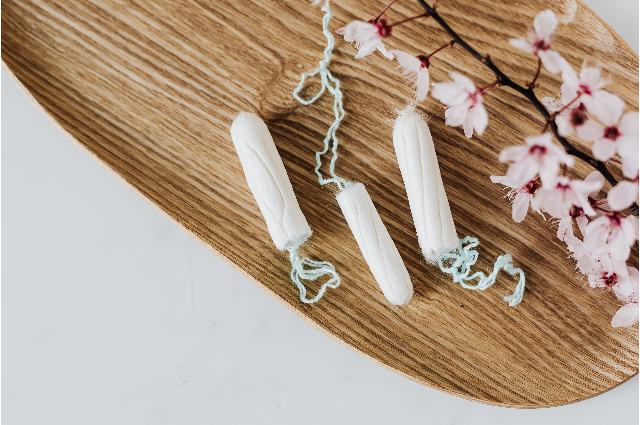
Health is intrinsically linked to the Right to Life and is fundamental to the existence of a dignified life. Menstrual health is one of the numerous aspects of health that the government ignores. In India, the menstrual class is surrounded by several unscientific misconceptions, cultural norms, and social practices condoned by patriarchal notions. Taboos, beliefs, conventions, and practices label menstruation as an impurity, linking it with a stigma, and so creating a barrier to guaranteeing menstrual cleanliness and, more significantly the menstrual health. In India, a nascent recognition of menstruation health and cleanliness as a human right has recently gained traction. However, as the right to health is not an express constitutional right in India, the government’s efforts to safeguard menstrual health are ambiguous and ineffective. The article indicates that the government’s existing approach to menstrual hygiene and health is neither “health-focused” nor “human rights-focused,” putting women’s health at risk, violating their rights, bolstering bias, and causing the menstrual disparity.
INTRODUCTION
“Menstruation is not a problem, but menstrual health and menstrual hygiene are”
Menstruation is a biological process that occurs naturally. All menstruators should be able to experience menstruation with dignity. However, this occurrence was labelled as “sin” and “pollution” due to scientifically baseless beliefs and prejudices. Since time immemorial, it has associated them with stigma, resulting in numerous limitations and taboos. Menstruation is considered a “condition producing incapacity” in India’s patriarchal society, making it an uncomfortable and undignified experience when managing menstrual hygiene and preserving menstrual health. Such experiences have a negative influence on the dignified enjoyment of fundamental rights, putting the health, progress, and empowerment of the menstrual class at peril.
In India, there has recently been a growing awareness of menstruation health from the need to protect it as a human right. Menstrual hygiene and health are portrayed only as a “women’s issue and a necessity for women’s freedom” due to a general lack of awareness about menstruation and the associated misconceptions generated by menstrual beliefs. Menstrual hygiene deficiency, on the other hand, is just a “sanitary and infrastructural concern.” In India, where there is no express constitutional right to health, state actions affected by menstruation ideas have proven to be unguided and wrong.
MENSTRUATION, MENSTRUAL HYGIENE, AND MENSTRUAL BELIEFS
Ensuring the right to health can provide actual meaning to living a dignified life. World Health Organization, Constitution of the World Health Organization, 22 July, recognises International Covenant on Economic, Social, and Cultural Rights, 1966 “Everyone has the right to enjoy the best attainable degree of bodily and mental health.” Individual menstruators’ health, as well as the health of the general public, can be seriously harmed by a lack of or improper menstrual hygiene. Menstrual health and cleanliness are topics that have recently gotten the attention of the government, thanks to their inclusion as a Sustainable Development Goal. This section of the chapter opens with a discussion of the biological phenomena of menstruation to fully comprehend the need of ensuring the right to menstrual hygiene.
Menstruation – the phenomenon
The Merriam-Webster dictionary defines menstruation as the “cyclical discharging of blood, secretions, and tissue debris from the uterus that recurs in non-pregnant breeding age primate females at approximately monthly intervals and that is considered to represent a readjustment of the uterus to the non-pregnant state following proliferative changes accompanying the preceding ovulation.” Menstruation is a phenomenon that occurs every month as part of the menstrual cycle, which is a complex, natural biological occurrence that keeps the female body fertile for a prospective pregnancy. A healthy menstrual cycle is the result of the cumulative effect of the uterus and cervix, ovaries, fallopian tubes, brain and pituitary gland, and vagina's essential roles. During menstruation, the body sheds the endometrial lining of the uterus, which thickens to allow a fertilised ovum to implant. As a result, along with blood, the expelled menstrual blood comprises mucus, tissues, and fluids. Menstruation happens every 28 days for the majority of women. Menstruation is referred to as periods or monthly because of their cyclic nature.
A Menstruators is a female who is having her period and includes girls, women, transgender, and non-binary people. 16 The onset of this phenomenon usually occurs at the start of adolescence and is accompanied by changes in their physical appearance, biochemistry, and psyche. 17 It is a hormone-controlled transitional time during which a female requires a great deal of biological and emotional attention and support.
Menstrual Hygiene healthy and unhealthy practices
According to the Collins Dictionary: Hygiene is the practice of keeping yourself and your surroundings clean, especially to prevent illness or the spread of diseases.” As a result, be those behaviours that all menstruators must comply with to keep the entire body, particularly the vaginal area, clean, infection-free, and disease-free hygiene habits. It is especially crucial to avoid the health repercussions of individual and public health effects by following safe and healthy hygiene habits. As a result, menstruators must adhere to proper and safe hygiene habits throughout menstruation.

The following are some of the procedures that can be taken to ensure safe hygiene practices during menstruation. Menstruators must remember the following as optimum hygiene measures:
- Washing hands before and after using/applying sanitary products with unsoiled water and mild soap.
- Cleaning external genitalia with unsoiled water and mild soap.
- Keeping the genital area dry.
- Having access to safe and clean menstrual hygiene products.
- Using sanitary napkins properly, etc.
These are the practices of sanitary materials. Menstrual hygiene is a deciding factor for maintaining menstrual health, the rights of the entire menstruating class, and the reproductive rights of all female members of society, so it is safe to deduce that it is a deciding factor for maintaining menstrual health, the rights of the entire menstruating class, and the reproductive rights of all female members of society. Diseases and infections can come from not following hygienic menstruation practices, which can have major health consequences. Reproductive tract infections, urinary tract infections, cervical cancer, fungal and bacterial infections, rashes and allergies near the genital area, toxic shock syndromes, other vaginal diseases, and psychological problems are among the infections and diseases that can result from various unsanitary practises capable of causing grave health implications both to individuals and to the general public in the form of reproductive tract infections, urinary tract infections, cervical cancer, fungal and bacterial infections, rashes and allergies near the genital area, toxic shock syndrome.
The above observation certainly conveys the importance of menstrual hygiene violations on both menstruators and the general public’s health. This section of the Chapter now focuses on the informational and structural components that play a vital role in the adoption of regular, healthy behavioural habits.
Menstrual Beliefs In India
Menstrual beliefs are a reflection of a culture’s or religion’s misconceptions and attitudes towards menstruation. Religion, superstitions, and social conceptions all have a great influence on menstruation in India; they become elements that influence menstrual hygiene habits and have an impact on menstruators’ and public health. Various studies and literature on menstrual beliefs and taboos in modern India show that old menstrual beliefs are still practised in urban, rural, and tribal communities.
In patriarchal India, menstrual beliefs limited the scope of menstruation to women and girls and considered menstruation as a chance to discriminate against and control women based on purity and status, respectively. The following paragraphs provide a quick overview of how Indian menstrual beliefs viewed menstruation.
Firstly, Menstruation is used as a chance to discriminate against women by making it filthy, dirty, and polluted. The patriarchal attitude of the time is reflected in the fierce promotion of the concept that menstruating females are dirty and impure, compelling them to suffer various taboos during menstruation. The relationship between religion and menstruation governed the menstruator's behaviour by assigning ceremonial impurity and associated unbending restrictions. Due to the notion that the poisons carried by a menstrual female were capable of spreading and causing illnesses and the limits were enforced with complete support. As a result, it is only right that she be kept in seclusion and hidden during her menstrual cycle. The norm established in the early days is evidenced by literary readings and behaviours of various cultures.
Secondly, menstruation provided an easy way for men to exert control over women by lowering their status. Since time immemorial, patriarchal Indian society has condemned women to a lower position in order to restrict women’s strength and preserve their inferiority. Menstruation was portrayed as a disability, allowing female menstruators to be lumped in with polluting animals like dogs, as they lacked control over their bodies and inhibited female members from going about their everyday lives. When viewed in terms of utility, menstrual blood was portrayed as pollution, and dirt when compared to men’s fertility. Menstruation was thus defined as the time when female menstruators were untouchable and unreachable to males. It spawned a practice similar to Nepal’s Chhaupadi, in which female menstruators were required to leave their homes and avoid being seen by their husbands and other male family members. This custom is still practised in rural India today.

As a result, the menstrual beliefs had a profound impact on the menstrual cleanliness and health of both women and girls. Female menstruators, for example, were forbidden from bathing or washing their hair because they defiled holy water sources that were supposed to cleanse the gods. Superstitions portraying menstrual fluid as capable of delivering curses and a powerful component in performing black magic bolstered this notion. Because of these beliefs, women did not change the absorbing material they used during menstruation, and in many cases, they used unsanitary absorbents like leaves, dirt, and cow dung cakes, which were simple to dispose of without being seen. To avoid ruining the floors, they also avoided using lavatories.
The preceding examples demonstrate the lack of attention paid to women’s and girls’ menstrual hygiene and health, as well as how irrational and unscientific menstrual beliefs influenced many of the best menstrual hygiene practises mentioned above, resulting in various reproductive, urinary, and sex-related infections in female menstruators.
STATE TO ENSURE MENSTRUAL HYGIENE AND HEALTH IN INDIA
The Right to Health is recognised explicitly as a Directive Principle of State Policy and indirectly as a Fundamental Right in India’s Constitution. The Supreme Court of India has ruled that state policy directives and fundamental rights must be balanced and supported in order to fulfil the country’s different goals and aspirations, and that neither is superior to the other. Menstrual hygiene ensures menstrual health and protects the right to health in the current situation. Aside from the constitutional framework, the State’s Sustainable Development Goal commitments include menstrual hygiene and health.
1. Constitutional scheme
The Directive Principles of State Policy (Part IV) and Fundamental Rights in India are the result of a search for a constitutional plan to ensure the right to menstrual hygiene and health. As a result, one can deduce that:
- In addition to attaining progressive public health, the state has a primary responsibility to strive for menstrual hygiene and health and to actualize a higher level of living.
- The state should create measures and facilities that provide a just and compassionate work environment for practising menstrual hygiene and ensuring menstrual health throughout menstruation.
- The state is responsible for ensuring menstrual hygiene and health so that children have access to the opportunity and resources they need to develop healthily while maintaining their independence and dignity.
- Due to its positive commitment, the state must strive to ensure menstrual cleanliness and health to assist the menstruators in obtaining sufficient means of livelihood.
- The State must create and execute policies to ensure menstrual cleanliness and health, ensuring that there is no inequity, discrimination, or abuse based on their strength or physical phenomenon.
- The State shall make every effort to provide menstrual hygiene and health for the well-being of its residents, reduce income disparities, and eradicate inequities in opportunities, facilities, and status owing to any biological occurrence.
After indirectly conferring with the status of fundamental right, one way to tackle this topic is to consider the repercussions on other fundamental rights when menstrual cleanliness and health are damaged, absent totally, After indirectly conferring with the status of fundamental right, one way to tackle this topic is to consider the repercussions on other fundamental rights when menstrual cleanliness and health are damaged, absent totally, or denied. The following are the rights that are affected: To begin with, the Supreme Court of India has ruled on several times that the right to life encompasses the right to health, and that upholding that right is an intrinsic component of the State's responsibility. 52 As a result, poor menstrual hygiene and health can lead to a variety of reproductive and other health difficulties for both menstruators and the wider public. As a result, it has a significant impact on the right to health. denied. The following are the rights that are affected:
Firstly, the Supreme Court of India has ruled on several times that the right to life encompasses the right to health, and that upholding that right is an intrinsic component of the State’s responsibility. As a result, poor menstrual hygiene and health can lead to a variety of reproductive and other health difficulties for both menstruators and the wider public. As a result, it has a significant impact on the right to health.
Secondly, Menstrual hygiene and health can jeopardise the right to a dignified existence and the right to privacy. Because the right to health is so important for living a dignified life, the state should make every effort to ensure it. As a result, the State is obligated to create and provide accessible facilities that enable women to enjoy menstrual hygiene and health in a discrimination-free and difficulty-free manner. Menstrual hygiene and health necessitate a private and safe area to wash, as well as access to water, the capacity to change absorbent materials, and the ability to dispose of or wash the material for reuse.
Thirdly, the right to education is harmed by a lack of menstrual cleanliness and health. Girls' exposure to ancient and archaic behaviours that impact their health, safety, dignity, and privacy continues to this day in many parts of the country, with the cumulative effect compromising their cleanliness and health, thereby denying them of their right to education. According to studies, the lack of understanding about menstrual hygiene and hygiene products, as well as the lack of availability and access to menstrual hygiene products, are the leading causes of females dropping out of school. For many young girls, it makes menstruation a humiliating experience. As a result, they miss lessons, which has a negative impact on their education, involvement, and empowerment.
Fourthly, Menstrual hygiene and health can have an impact on one's ability to work. Most organisations and working environments are unconcerned about menstruation, exposing women to workplace discrimination and harassment. When there is structural insensitivity to the phenomena of menstruation, it is impossible to practise menstrual hygiene and experience menstruation. Working in such an environment has a negative impact on menstruators' ability to participate fully in the workforce, eventually leading to their dismissal.
Finally, The right to equality and nondiscrimination might be harmed by a lack of menstrual hygiene and health. Female menstruators are stereotyped as a result of menstruation beliefs and the patriarchal system in the country. Furthermore, it leads to negative views toward menstruation and the perception of the event as a burden. In many cases, the phenomena are used solely for the sake of exploitation, abuse, inequity, and prejudice.

In the case KS putuswamy v. Union of India, the Supreme Court of India recently took a step forward by declaring Article 17 to be an anti-exclusion principle in the context of menstruation. The Supreme Court ruled that concepts of “purity and filth” stigmatise people and have no place in a constitutional system. In one way or another, socially isolating women because of their menstrual condition equates to untouchability. Article 17 of the Indian Constitution severely condemns the practice of untouchability as a form of discrimination that degrades people’s dignity.
2. Sustainable Development Goals
Aside from the constitutional framework, the state also addresses menstrual hygiene and health issues as part of the 2030 Sustainable Development Goals. Different goals, including as good health and well-being, quality education, gender equality, clean water and sanitation, and decent employment and economic growth, can be closely related to menstrual hygiene and health, where States must meet their obligations.
Menstrual hygiene is addressed in India under the Swacth Bharat Mission’s Menstrual Hygiene Management. It is a government of India-led development and welfare programme aimed at achieving the target set out in Sustainable Development Goal 6. The Swachh Bharat Mission is divided into two parts: Swachh Bharat Mission-Gramin, which is overseen by the Ministry of Drinking Water and Sanitation, and Swachh Bharat Mission-Urban, which is overseen by the Ministry of Housing and Urban Affairs. The SBM aspires to make India free of open defecation by incorporating MHM into the national rural sanitation programme.
HEALTH AND HUMAN RIGHTS FOCUS
In India, a contemporary movement focused at recognising menstruation health and cleanliness as a right has gained traction. While the country’s menstrual rights regime is still in its infancy, the need for more proactive actions and processes in the form of sensitive laws and policies to address the issues of creating an accepting and supportive attitude toward the phenomenon of menstruation, menstrual hygiene, menstrual health, and menstrual rights is more important than ever. In the study “Water Supply and Sanitation Collaborative Council, India, Menstrual Hygiene Management (MHM) Guidelines and implementation Framework” the need for sensitivity and transformation is visible:
“a government-run institution for mentally challenged girls in India came into the public eye because 17 women (ranging from 15 to 35 years of age) were brought into the district level government teaching hospital for hysterectomies. The reason for (the Dept. Of women and child welfare) permitting the hysterectomies was that it facilitated the “easy management of menstruation.” Even though they had tried their best, the Class IV employees (cleaners, sweepers, etc.) were unable to handle the mess, and thus they were sure that this was the only solution left.”
Well, the above paragraph demonstrates the risks of the state’s and medical fraternities’ full insensitivity to the phenomena of menstruation, menstrual hygiene and health, menstrual rights, and the challenges of the vulnerable population during menstruation.
From health, human rights, and sustainable development goal perspective, the OUGHT TO Approach shows how India should ensure the right to menstrual health and hygiene. India should fulfil its human rights obligations as a signatory to numerous key international human rights treaties, including the International Covenant on Civil and Political Rights, the International Covenant on Economic, Social and Cultural Rights, the Convention on the Rights of the Child, and the Convention on the Elimination of All Forms of Discrimination Against Women.
To achieve the right to health and other associated human rights such as non-discrimination and gender equality, right to dignity and privacy, right to water and sanitation, right to education, and right to employment, the state must provide menstrual hygiene and health. As a result, the OUGHT TO strategy can address all of the issues surrounding the right to menstrual hygiene and health.
CONCLUSION
The first part of this essay was on the reasons supporting concluding that India’s menstrual beliefs have obscured the negative health effects of poor menstrual hygiene on the entire menstruation class and their worries. Similarly, the explanations concluding that the State approach to ensuring menstrual hygiene and health is misguided and jeopardises the health of the entire menstruating class violates various human rights, reinvents gender discrimination, and results in menstrual inequity. The essay concludes by asserting that, in light of the foregoing discussions, the state has a legitimate role and obligation to ensure the right to menstrual hygiene and health, to address the menstrual concerns of the entire menstruating class, and to protect the right to menstrual hygiene and health.
Menstruation is a natural occurrence that is unrelated to society attitudes and beliefs, but experiencing it in a dignified manner is important. This phenomenon is critical to humanity’s long-term existence in a variety of ways. As a result, India should allow its women and girls to menstruate with dignity, since if they do, they will begin to care for their health and, as a result, will become their mates.
